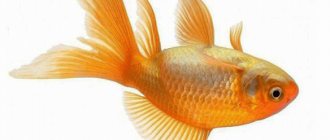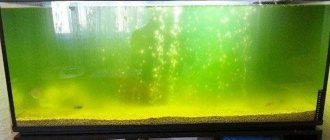- The water in the aquarium becomes cloudy: reasons
- Turbidity in the aquarium and its types
- Green water in the aquarium
- The water in the aquarium is cloudy and white
- The water turns yellow
- Bubbles on the surface of the water
- Film on water
Diseases, death of fish, plants, microorganisms invisible to the eye - cloudy water in an aquarium can lead to such negative consequences (you will read what to do in this case in the article).
Experienced aquarists assure: it is necessary to act thoughtfully, promptly, and listen to the advice of professionals. Do not panic if the water in the aquarium becomes cloudy. All fish breeders may face a similar problem. On the contrary, you need to find out as quickly as possible why the water in the aquarium is becoming cloudy, and do everything necessary to restore the water balance and clean the tank.
What does the color of the haze mean?
Cloudiness comes in different colors. Color may explain the reason for such changes. Most often, the water turns cloudy to green, brown, red or milky.
- For example, if the water in an aquarium is green , then most likely the reason is single-celled green algae that are rapidly developing in the aquarium. Such algae are absolutely harmless to fish, so you can fight them only for the sake of the aesthetic appearance of the aquarium.
The water may also appear cloudy brown . Most likely the reason is driftwood, which is used as decoration. New driftwood releases tannin and humic acids into the water, turning it a cloudy brownish color.- Another color option for water is red . The problem here is most likely with the fish food. It is either not of sufficient quality, or the aquarist overfeeds the fish, which is why particles of food remain uneaten, are crushed in the water and color the aquatic environment.
- White turbidity is usually due to the fact that the environment contains a lot of bacteria and ciliates that multiply in it. Typically, the water becomes a cloudy white color due to excess organic matter that the filter cannot handle.
The water in the tank began to become cloudy and smells like a swamp: causes, prevention.
“Why does the water smell like a swamp? The whole underwater world smells like mud! The water is cloudy! What should I do? How to remove terrible odors? The answers are quite simple, if you are attentive, you have already received one. Let’s repeat and consolidate: insufficient amount of oxygen (water circulation problem). When there is not enough oxygen, the water quickly becomes cloudy. Fish burrow under stones and muddy the water. Proceed as follows: reset the aeration and clean the filter. Hydrogen peroxide also has the ability to saturate water with oxygen. It will be useful to purchase a device that measures the pH level of water.
The second answer is also given above: a large amount of peculiar feces released by fish due to crowded conditions and oversaturation in the tank. This causes the water to become cloudy very quickly. There is no need to talk about the fact that the water “smells”. Place the fish and clean the aquarium. In addition to oversaturation of the aquarium, the reason may be the following: the inhabitants are not compatible with each other. Then the same thing happens: copious discharge of disgusting-smelling feces.
When the pH level in the water is insufficient, the soil turns sour and silt appears. As a consequence, the appearance of hydrogen sulfide is inevitable. The presence of this substance in the tank will not bring joy to your pets.
In two out of three cases, the water becomes cloudy due to plants. There are two options here:
- There is not enough space for plants.
- There is plenty of space for plants.
Accordingly, you should offer them a new habitat: a larger or smaller aquarium.
In order to prevent terrible odors and cloudiness of the water in advance, you need to do the following: get aquarium “orderlies” (snails, speckled catfish, ancistrus and others). They will help keep the tank clean, beautiful, and healthy.
Why did it become cloudy?
What could have caused this? It is very important to understand the cause of the cloudiness, only then can the problem be dealt with.
Bacteria are the main cause
One of the most common reasons is bacteria, or rather their bloom. This phenomenon often occurs in newly started aquariums, since the formation of a bacterial ecosystem takes some time. However, the bacteria usually stop blooming after a few days.
Low quality feed
Bad fish food quickly dissolves in water, which is why the fish do not have time to eat it . Because of this, the water becomes brown or reddish in color. Granular feeds themselves dissolve in water much longer than flake feeds, so it is better to give preference to them. But there are also good flake fish food that will not spoil the appearance of the aquarium, so you should try different types of food.
Excess food for fish
The quality of the food may be high, but the water still becomes cloudy and colored. This happens because the fish get full and do not eat all the food offered. After some time, any food begins to get wet in the water and “dust”, so the appearance of the aquarium becomes extremely unaesthetic.
Problems with the soil or improper care of it
The aquarium environment may become cloudy due to the soil.
Light soil without a sinking fraction is not able to settle to the bottom even a few days after installing the reservoir.
Such soil is deadly for all inhabitants of the tank. The problem may also be that the sand or soil was not washed well enough before being poured into the aquarium.
Seaweed
Green algae can multiply very actively, causing the water to become cloudy and green. and adding plant fertilizers can encourage algae growth The absence of competitors in green plants (for example, brown or any other algae) leads to very active growth of a certain species.
Reservoir overpopulation
There should not be too many fish in the aquarium. In this case, they may begin to dig up the soil or sand, causing the water to be constantly cloudy. Also, the filter may not be able to clean the water of an overcrowded aquarium. The waste produced by the fish will not settle or be cleaned properly, which can be fatal to the inhabitants of the pond.
Filter problems
Even if there is a filter, the water may become cloudy, so the aquarium filter must be designed for a certain volume of the tank. Otherwise, the filtration will be insufficient, which is why the water may become cloudy, dirty and insufficiently saturated with oxygen. If the filter power is high enough, then the problem may be that the filter is clogged or not cleaned well enough.
Incorrect water change
If the water was changed incorrectly, the environment in the reservoir may become cloudy . Water should not be changed too often or in large volumes.
Excessive water changes greatly reduce the population of beneficial bacteria, resulting in a decrease in their ability to process fish waste, and their place in the ecosystem is taken by other, useless, blooming bacteria.
Replacing a large portion of the water can also affect the water chemistry, further reducing the population of beneficial bacteria in the filter.
Poor quality decorative elements
Some low quality aquarium decorations can oxidize in the water, causing the water to become cloudy. It is also possible that the paint will begin to peel off from the decorative jewelry, or the dye will simply begin to wash out. Such phenomena are dangerous not only from an aesthetic point of view, but can also harm fish and other aquarium inhabitants.
Poor and irregular care
Aquariums need to be cleaned, replaced with water, and controlled for the reproduction of fish and plants.
Lack of proper care leads to the fact that the tank becomes dirty , the fish population either increases or decreases sharply, and algae can grow to the point that it interferes with other inhabitants of the aquarium.
Therefore, life in the tank must be carefully monitored and controlled. Without proper care, the fish may die.
Unnoticed dead fish
Sometimes it happens that the aquarist did not notice the dead fish in the aquarium. Even a small fish can have a very strong impact on the aquarium ecosystem.
What could be the reason?
There may be several reasons why the water in an aquarium takes on a milky tint.
New Aquarium Syndrome
When you first start an aquarium, it takes time to establish balance in it. Beneficial bacteria, plants and other inhabitants have not yet become full participants in the nitrogen cycle.
It proceeds according to the following scheme:
- A high concentration of ammonia is created, which is produced by fish.
- The population of bacteria that process ammonia is increasing.
- Ammonia levels drop, but equally toxic nitrites appear in large quantities.
It is at these stages that the increased concentration of ammonia in the water, and then nitrites, causes the water to turn white.
The cycle ends with the birth of bacteria, which oxidize nitrites, releasing the final product - nitrates . These are no longer such “evil” bacteria, and their level is easily regulated by nature itself.
Bacteria begin to work as a biofilter, simultaneously reducing the whiteness of the aquatic world.
Another reason for whitish water is the use of poorly washed soil when starting the system. This usually appears soon after filling the aquarium.
Excessive water changes
Whiteness sometimes causes trouble not only in aquariums with fresh water, but also in well-established aquatic systems.
The reason for this is large volumes of replaced water, usually more than 30%. With this “refreshing” of the aquarium, beneficial bacteria are simply washed away.
As a result, the nitrogen cycle is disrupted, and whitish turbidity appears in the aquarium. One of the important rules of aquarium keeping is not to make a 100% water change unless necessary.
Bacterial outbreak
Another reason for a force majeure situation with the appearance of white turbidity in an established aquarium can be a bacterial outbreak. This is a massive proliferation of bacteria.
The main causes of bakflash:
- excessive portions of food that is not eaten by fish;
- excessive concentration of its inhabitants, inappropriate for the volume of the aquarium;
- overdose of fertilizers;
- absence or malfunction of filtration and oxygen enrichment systems;
- irregular cleaning of the aquarium;
- absence or insufficient soil layer.
The main process of biological purification occurs in the soil, and it is in it that colonies of beneficial bacteria settle.
What does the dregs say?
Cloudy water is just one of the symptoms that must be dealt with.
On the second day after the first launch
In a new aquarium, the water may become cloudy after starting for several reasons. First of all, this can occur due to the abundant proliferation of bacteria. In a new environment, bacteria multiply very actively in order to spread and occupy the entire territory. After a few weeks, the bacteria will stop multiplying as quickly and the water will clear up.
Also, in a new tank, the environment may become cloudy due to light particles of soil or sand that rise due to adding water or simply filling the tank.
The medium may become opaque due to wood decor that has not been pre-soaked for several days.
After substitution
The reason may also lie in the soil - if a stream of water is directed straight to the bottom, then the grains of sand rise, creating a visual impression of cloudiness in the water.
New water may become cloudy due to the proliferation of single-celled algae. After starting a reservoir where the lighting is too bright and the aeration and filtration system is poorly established, algae actively multiply, causing turbidity.
After restart
After a restart, bacteria that are under stress can cause cloudiness. The problem may also be gravel or sand that is not washed well enough.
Additional information and recommendations
When fighting whitish turbidity, you should refrain from changing water even in small quantities. The new liquid will provide additional nutrients to the growing colonies of bacteria. Therefore, it will not be possible to purify muddy water in this way.
When starting a new tank, you should add water from old aquariums to it. It will have a beneficial effect on the microclimate in the “home pond”. The resulting clouding in this case will disappear after 3-5 weeks. The water in a new aquarium should be changed only after 3-4 months of use.
For effective natural water purification in an “artificial pond”, it is worth adding several snails and daphnia (small crustaceans that live at the bottom of the tank) to the fish. These underwater inhabitants successfully destroy food debris, eat algae and fight bacteria.
Additional recommendations
- To prevent the liquid from acquiring a dark color due to the use of wooden elements, driftwood, twigs and other accessories for the aquarium should be thoroughly rinsed and then soaked for at least a day.
- When choosing soil for tanks containing goldfish and species that prefer to swim close to the bottom, you should give preference to a soil layer with large granules. Fine river sand will create constant turbidity due to the activity of underwater pets.
- You can add regular activated carbon to the water rather than using special carbon filters.
- Before applying a chemical effect, unless the instructions say that the product is completely safe, fish and other inhabitants of the “home pond” must be placed in a jar of clean water.
- When fighting growing algae, it is not enough to simply cut down on the supply of artificial light. It is necessary to protect the aquarium from direct sunlight.
- Any filters must be washed regularly under a strong stream of running water.
- From time to time, you should conduct a home study to evaluate the amount of ammonia, phosphates, nitrates and nitrites in the water, which can affect its clarity. You can purchase special kits for this procedure in pet stores.
- When choosing a new aquarium, you should give preference to large tanks. Their volume will allow the internal biological equilibrium in the water to develop faster, due to which the initial turbidity of the liquid will disappear faster.
- It is worth regularly inspecting the tank with aquatic inhabitants and inspecting the fish. Dead fish that are not removed from the aquarium in time quickly decompose. And this provokes the proliferation of pathogenic bacteria inside the “home pond”.
- Never fill the tank with tap water. It must first be left for 10-14 days. If you don’t have time to wait, then you should clear the water of chlorine and other impurities using neutralizing drugs sold in pet stores.
- Water that is too soft and does not contain any salts or magnesium is unsuitable for aquarium fish. It is possible to reduce the hardness of the liquid, but not completely eliminate it.
Proper care of fish, including proper water purification, is a troublesome task and requires sufficient patience. However, following all the recommendations, taking into account the characteristics of the fish, it is so difficult to get rid of cloudy water in the tank. Thus, you will simplify the process of keeping underwater pets.
What does the smell say?
Why does the water stink? The smell often appears somewhat later than cloudiness, as a second sign of improper care. Let's look at the main reasons why there may be an unpleasant odor:
- The most common reason for a bad smell from a tank is lack of thorough and regular maintenance.
- The environment may also smell unpleasant due to poor filtration or insufficient oxygenation.
- If the wrong plants are chosen for the aquarium, this can also cause a bad smell.
- It’s also worth checking to see if the body of a dead fish is left somewhere. The body begins to decompose and this causes an unpleasant smell.
- Problems with the quality of food or overfeeding the inhabitants of the reservoir also lead to the appearance of an unpleasant odor.
- Too many inhabitants in the aquarium - as a result - a musty smell from the tank.
How to deal with this?
So, how to eliminate the causes?
- In some situations, for example, in the case of starting an aquarium for the first time, it is better to do nothing at all. After a few weeks the water will become clear.
- Sometimes it is necessary to partially or completely replace the water. Changing the food or feeding the fish in smaller portions may also help.
- If the water is colored by the decor, then it should be removed and washed or soaked, and the aquarium water should be cleaned with activated carbon.
- Certain types of algae or snails can help purify the water.
- You should also clean the filter and make sure that its power is sufficient to purify the water and saturate it with oxygen.
- In some cases, completely cleaning the aquarium and then changing the water can help.
How to quickly fix the problem?
What needs to be done to eliminate the unpleasant odor? A radical method is general cleaning, in which all contents are cleaned:
- Remove all the fish from the aquarium using a net, place them in a jar of water;
- Consistently clean the bottom, walls, plants, decorative elements;
- Clean the filter;
- Remove rotted algae;
- Change or replace the water.
You can quickly and effectively eliminate odor in an aquarium using carbon filtration (you need to purchase special aquarium carbon that does not emit phosphates and does not generate dust).
- Cut a hole in the bottom of the bottle;
- At the top, cut a small hole for the air tube;
Wrap the coal in padding polyester, place it in the lower part of the bottle, and also put a pebble down that will hold the device at the bottom;- Insert the end of the tube into the top hole of the bottle;
- We connect a homemade filter to the compressor.
This device will allow you to quickly get rid of unpleasant odors.
Prevention
It is much better to avoid the appearance of turbidity than to deal with the consequences. To prevent such unpleasant phenomena, complex special actions are not needed.
All you need is regular and thorough maintenance of the tank: cleaning the aquarium, partial water changes, and high-quality food. You need to be careful when choosing decor for the tank and filter, and clean all the necessary elements on time . Don’t forget about the other inhabitants of the aquarium - snails and algae will be excellent helpers in the fight against cloudy water.
The most important thing in prevention is not to overfeed the fish. If this does happen, then you need to remove excess food from the bottom of the reservoir yourself. It is also important to regularly rinse the bottom filler with the aquarium siphon - this is a good preventative measure that will definitely protect the reservoir from clouding the environment.
Means to combat water turbidity
So, how to deal with this unpleasant moment. First of all, it is necessary to determine and then eliminate the reasons for the constant turbidity of the main fluid for your fish.
If the cause is overfeeding the fish, you need to reduce the amount of food. If water filtration is poor, buy a better filter or update the old one.
It is worth considering all the points when filling a new fish tank with water, populating the aquarium and when choosing decorations, do not forget to regularly and properly clean the aquarium, pay due attention to the light falling on the “fish house”, the presence and need of algae in the aquarium.
To quickly clean your aquarium you can use:
- Aquarium charcoal.
- Tetra Aqua Crystal Water.
- Sera Aquaria Clear.
Aquarium carbon is poured into the aquarium filter after cleaning and lasts for two weeks. It is an absorbent - a substance that absorbs other substances. It is necessary to clean the aquarium every 14 days, and then replace the carbon in the filter.
The other two products collect small particles in the water (remnants of food, particles of soil) into larger ones, which then settle to the bottom and are removed after cleaning the aquarium or are absorbed through a filter.
Other interesting articles
- Why the filter in the aquarium does not work after cleaning A working aquarium filter is the key to maintaining the health of the aquarium. Sometimes it happens that the aquarium filter stops...
- How often should you change the filter sponge in an aquarium? The filter in an aquarium is the most important piece of equipment, a life support system for your fish, removing…
- Boiled water is not suitable for fish to live in an aquarium. Water for an aquarium is a very important component that allows you to keep fish healthy. Not always available...
Video on the topic
The video will tell you why the water can become cloudy:
Following simple rules will allow you to never encounter such a problem as cloudy water. And if such a situation suddenly occurs, then you can easily cope with it - just correct it and establish proper care for the aquarium.
- Related Posts
- Is the water in the aquarium turning green? Why does this happen and how to deal with it?
- Find out why water foams in an aquarium
- Cloudy water in an aquarium can kill the inhabitants! What can I do to make the liquid crystal clear again?
How to Get Rid of Muddy Water: Options for Solving the Problem
To get rid of the unfavorable reasons that cause cloudy liquid in a fish tank, you can choose one or more of the methods given below.
- Relocate fish if their number significantly exceeds the permissible limit for an aquarium.
- Reduce the amount of dry food and get rid of uneaten food. It is useful to give aquatic inhabitants a short-term diet, no more than 3 days. In a situation where it is certainly known that it is the food that affects the turbidity of the liquid, it is better to refuse to use powdered dry food. Give preference to “live food” in the form of aquatic mosquito larvae and worms, which can be purchased in specialized stores.
- In addition to cleaning the soil and glass of the tank, it may be necessary to replace the vegetation inside the aquarium. Especially in cases where the greenery is covered with an unpleasant film, there are dark spots on it and a putrid odor emanates from it.
- To successfully purify cloudy water, you should use carbon filters for aquariums. It would be useful to bring the soil into a favorable state using a special siphon.
- When cleaning opaque water, you should not replace all the liquid inside the “home pond” - this will not benefit the inhabitants. It is necessary to get rid of only 10-15% of old water every 2-3 weeks, replacing it with new one. The water in the aquarium after replacement may become cloudy either due to a large amount of fresh liquid, or due to the fact that the added water was not settled, boiled and was strikingly different in temperature from the water in the tank.
- Increased enrichment of it with oxygen will also help clear the cloudy liquid. However, you need to be careful about aeration so that small bubbles do not appear on the walls of the vessel with fish and on the vegetation and decorative decorations of the aquarium.
- To get rid of algae blooms, you need to reduce the amount of light directed at the “home pond”.
- In serious situations, coagulants can be used, which, in combination with the operation of filters, will have a beneficial effect on purification. And also use special biofilters containing two types of bacteria. They are able to reduce the amount of nitrites, nitrates, and phosphates in aquarium water.
When the water in an “artificial pond” becomes cloudy, the video below will tell you what to do:
In addition to the above methods of combating the turbidity of the liquid in a tank with underwater pets, you can resort to special products sold in zoological stores.
- "Tetra Crystal Water" cleanses from any turbidity.
- “8 in 1”, a drug that allows you to get rid of blooming and rapidly growing parasitic algae, destroys green turbidity in the water.
- "Sanex+EcoPrud" product is intended not only for home aquariums. It also helps in the case of small bodies of water, relieving them of liquid contamination.
- “Tetra AquaSafe” is an air conditioner that purifies cloudy water, destroys pathogenic bacteria, and fights some fish diseases.
- API Algae Destroyer Advanced is another effective algae killer.
- "Malachite Green" is an antibacterial agent for home aquariums.
It is necessary to clean cloudy water and the aquarium area in general using specially developed products at least once every six months. This will have a beneficial effect on the climate in the “artificial reservoir”, protect the fish from disease and death, and get rid of accumulated ammonia inside the tank.
Let's look at some popular drugs:
- Zeo Max Plus from the AquaEl brand. Zeolite is an absorbent that, unlike coal, copes well with nitrates and nitrites. Placed as a filler in a filter. But you shouldn’t keep it in the filter for more than a month.
- Fluval Zeo-Carb. Similar to the previous drug. But in addition to zeolite, it contains activated carbon.
- drug Toxivec from Sera. At the chemical level, it eliminates NO2NO3. Effectively removes hazardous substances and poisons that can threaten the health of fish. Since this is a chemical, it is recommended to use it once.
- Bactozym drug from the Tetra brand. The conditioner accelerates the process of stabilizing the biobalance in the filter.
- Nitran Minus Perls granules from Tetra. The granules are buried in the ground. Biologically reduce nitrate levels. Used to control algae.
- Nitrate Minus from Tetra. Conditioner that biologically improves water quality. Used to reduce nitrate levels.
- the drug Bio Nitrivec from the Sera brand. Used to quickly start an aquarium. Contains a mixture of cleansing bacteria for the biobalance of the aquarium.
Important! Before using any drug, you should carefully read the instructions. And strictly adhere to dosages.
HOW, WHAT AND HOW MUCH TO FEED GOLDFISH? DESCRIPTION PHOTO VIDEO.











